The adoption of no-tillage (NT) farming increased water use efficiency and allowed for cropping intensification, especially in semi-arid environments like western Kansas, because of greater soil water storage with more crop residue kept on the soil surface. With more residue retained in NT systems, wind and water erosion are reduced, and more organic matter accumulates in soil. However, despite these benefits, maintaining continuous NT has become increasingly challenging because of the lack of herbicide options for difficult-to-control and herbicide-resistant (HR) weeds, as well as issues with stratification of soil pH with increasing soil acidification near the surface.
The lack of effective herbicide options to control perennial grass weeds like tumble windmillgrass (Chloris verticillata Nutt.), tumblegrass (Schedonnardus paniculatus), and purple three-awn (Aristida purpurea Nutt.) as well as HR kochia (Kochia scoparia L.) and Palmer amaranth (Amaranthus palmeri S. Watson) pose some of the greatest challenges to long-term NT systems. With the increased costs of alternative herbicide options and increasing agricultural input costs, some farmers resort to tillage as a cost-effective strategy to manage weeds.
However, the decision to return to tillage after many years of NT management is difficult, as many farmers are concerned about losing the benefits accrued with long-term NT. Researchers at the Kansas State University Western Kansas Research-Extension Centers studied the use of strategic tillage in long-term NT fields to manage difficult-to-control and HR weeds and evaluated impacts on crop yields and soil properties over the past 8 years near Hays, KS.
What is strategic tillage?
Strategic tillage is defined as a one-time tillage operation in an otherwise NT cropping system to manage challenges of long-term NT (Figure 1), including difficult-to-control weeds and pH stratification. Following this strategic tillage operation, the system returns to NT. The most commonly used implement for strategic tillage is the sweep plow, which is a non-inversion conservation tillage implement. Inversion-type tillage with a disk may be preferable in correcting pH stratification if needed.
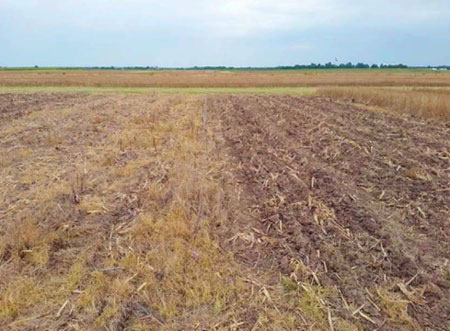
Figure 1. No-till (left) and strategic tillage (right) following tillage and fertilizer applications in fallow.
Impacts of strategic tillage
Following up on a previous study, researchers investigated the effect of one-time strategic tillage implemented in 2016 on soil properties and crop yields from 2017 to 2023 in otherwise long-term NT plots originally established in 1975 near Hays, KS. This experiment included three tillage treatments (NT, strategic tillage, and reduced tillage) and three crop rotations [continuous wheat (WW), wheat-fallow (WF), and wheat-sorghum-fallow (WSF)]. Tillage operations were implemented using a sweep plow equipped with pickers for effective weed control with minimal residue disturbance.
Soil properties
Results showed that soil organic carbon concentration under strategic tillage was not different from NT (Figure 2), whereas soils under reduced tillage had 8% less soil organic carbon. The wind-erodible soil fraction was not different among tillage treatments. However, the water-stable aggregate size under strategic tillage was similar to NT, and both were greater than under reduced tillage (Figure 3).
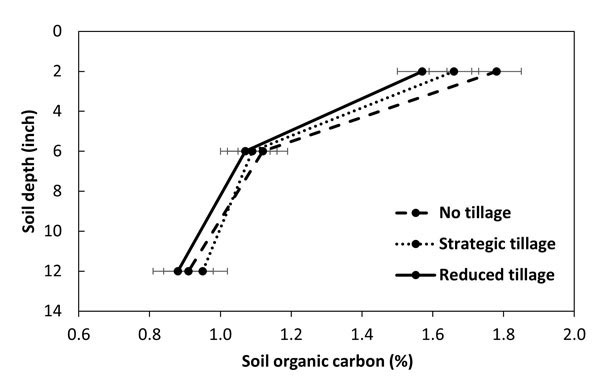
Figure 2. Tillage effects on soil organic carbon concentrations in long-term NT and RT (established in 1975) in comparison to strategic tillage (implemented in 2016) of long-term NT near Hays, KS. Error bars represent the standard error of the mean (P ≤ 0.05).
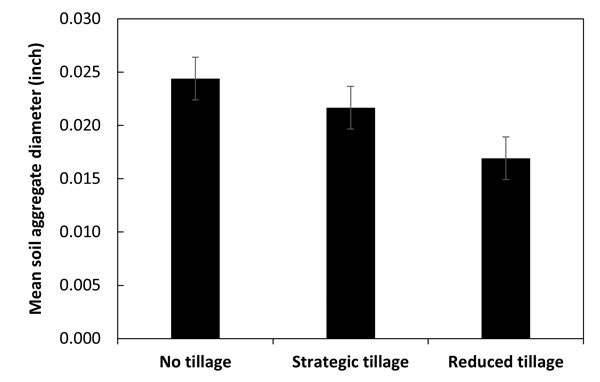
Figure 3. Tillage effects on the diameter of water stable aggregates in long-term NT and RT plots (established in 1975) compared to strategic tillage (implemented in 2016) of long-term NT near Hays, KS. Error bars represent the standard error of the mean (P ≤ 0.05).
Wheat and sorghum yields
Strategic tillage increased wheat yields compared to NT in WW, mostly due to improved weed control, though wheat yields were similar across tillage treatments in the WF and WSF rotations (Figure 4). Grain sorghum yield in WSF was not different between strategic tillage and NT treatments, though both were 12% greater than under reduced tillage (Figure 5).
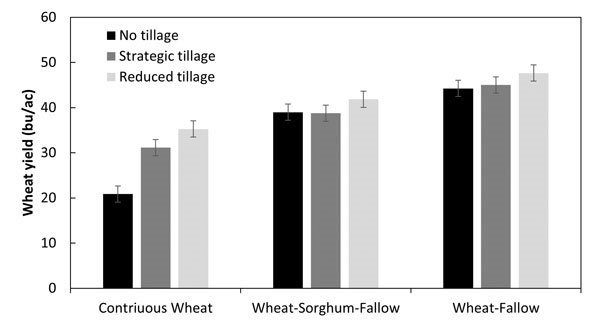
Figure 4. Averaged winter wheat yields (2017 to 2022) as affected by tillage and crop rotation near Hays, KS. Error bars represent the standard error of the mean (P ≤ 0.05).
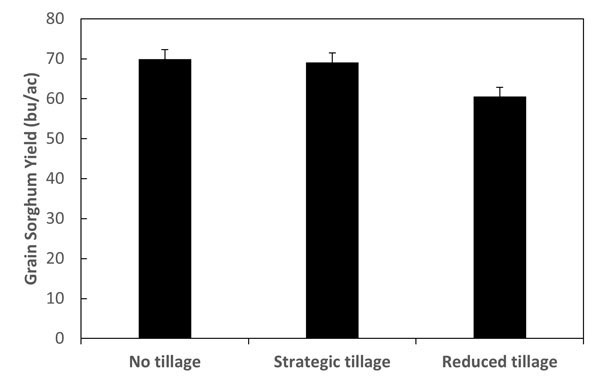
Figure 5. Averaged grain sorghum yield (2017-2022) as affected by tillage near Hays, KS. Error bars represent the standard error of the mean (P ≤ 0.05).
Summary
Overall, strategic tillage of long-term NT had no negative effect on soil properties or crop yields. This could be an effective tool for farmers to manage difficult-to-control weeds. However, farmers should be mindful of best practices when implementing strategic tillage:
- Strategic tillage with a sweep plow should be timed when soil erosion risk is lowest. In western Kansas, the best time is in summer fallow ahead of winter wheat.
- Timing is critical to ensure successful control of perennial grass weeds. Tillage should be implemented with a sweep plow equipped with pickers, operated at shallow depth, on a hot, dry day with no chances for rain for several days following tillage.
- The tillage depth should be kept shallow (1-2 inches) to control perennial grass weeds (most are shallow-rooted) and prevent the burying of crop residue. Deeper tillage may only spread and bury the weed rhizomes, increasing management challenges.
- The frequency of strategic tillage will depend on the time it takes for issues to resurge after returning to NT management, though it may be six years or more between operations. More frequent tillage may result in negative impacts on soil properties and crop yields.
For more detailed information on this study, please refer to: “Assessing the Influence of Strategic Tillage on Crop Yields and Soil Properties in Dryland No-Tillage Systems” in the 2023 Kansas Agricultural Experiment Station Research Reports: Vol. 9: Iss.64. https://doi.org/10.4148/2378-5977.8487.






